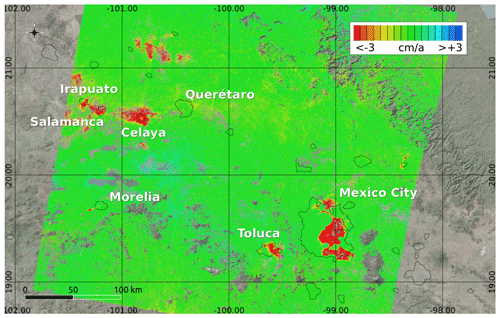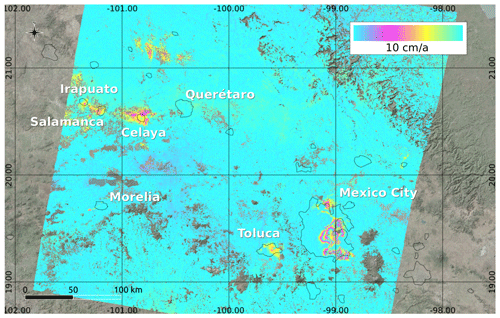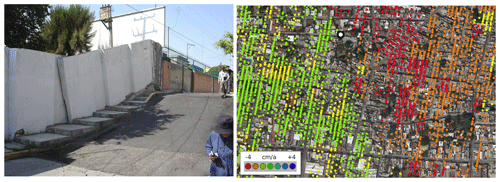Carreon-Freyre, D., Cerca, M., Gutierrez-Calderon, R., Alcantara-Duran, C.,
Strozzi, T., and Teatini, P.: Land Subsidence and associated ground fracturing in
urban areas, Study cases in central Mexico, Proc. of the XVI Pan-American
Conference on Soil Mechanics and Geotechnical Engineering, 9 pp., 2019.
Carnec, C., Raucoules, D., Ledoux, E., Huré, A.. and Rivera, A.: Mapping
and modelling of major urban subsidence on Mexico City from radar
interferometry, Int. Conf. Research and Application on Hydrogeological
Disarray in the World, The Fragile Territory, Rome, Italy, 7–10 December 2000.
Chaussard, E., Wdowinski, S., Cabral-Cano, E., and Amelung, F.: Land
subsidence in central Mexico detected by ALOS InSAR time-series, Remote
Sens. Environ, 140, 94–106, 2014.
Cigna, F., Osmanoglu, B., Cabral-Cano, E., Dixon, T., Ávila-Olivera, J., Garduño Monroy, V., Demets, C., and Wdowinski, S.: Monitoring land
subsidence and its induced geological hazard with Synthetic Aperture Radar
Interferometry: A case study in Morelia, Mexico, Remote Sens. Environ,
117, 146–161, 2012.
Ferrari, L., Rosas-Elguera, J., Carrasco-Núñez, G., Orozco-Esquivel,
M. T., and Norato-Cortéz, T.: Cartografía Geológica Digital de
la Faja Volcánica Transmexicana y áreas adyacentes, Digital
Geosciences, Vol. 2, J. Int. Geosc. Cartography, 2007.
Schneider, A., Friedl, M. A., and Potere, D.: A new map of global urban
extent from MODIS data, Environ. Res. Lett., 4, 044003, https://doi.org/10.1088/1748-9326/4/4/044003, 2009.
Strozzi, T. and Wegmüller, U.: Land subsidence in Mexico City mapped by
ERS differential SAR interferometry, IGARSS'99, IEEE 1999 International Geoscience and Remote Sensing Symposium, 4, 1940–1942, https://doi.org/10.1109/IGARSS.1999.774993, 1999.
Strozzi, T., Wegmuller, U., Werner, C. L., Wiesmann, A., and Spreckels, V.:
JERS SAR interferometry for land subsidence monitoring, IEEE T. Geosci.
Remote, 41, 1702–1708, 2003.
Tuxpan-Vargas, J., AlfredoRamos-Leal, J., Manuel Hernández-Madrigal, V.,
and Villaseñor-Reyes, C.: Land subsidence by groundwater
over-exploitation from aquifers in tectonic valleys of Central Mexico: A
review, Eng. Geol., 246, 91–106, 2018.
Vega, F. G. E.: Subsidence of the city of Mexico: a historical review, Proc.
2nd Int. Symp. Land Subidence, Anaheim, International Association of Hydrological Sciences, UNESCO publication No., 121, 35–38, 1976.









